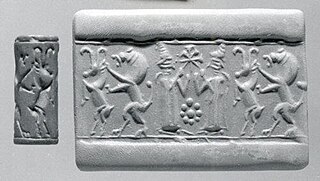An ideogram or ideograph is a symbol that represents an idea or concept independent of any particular language. Some ideograms are more arbitrary than others: some are only meaningful assuming preexisting familiarity with some convention; others more directly resemble their signifieds. Ideograms that represent physical objects by visually resembling them are called pictograms.

Akkadian is an extinct East Semitic language that was spoken in ancient Mesopotamia from the third millennium BC until its gradual replacement in common use by Old Aramaic among Assyrians and Babylonians from the 8th century BC.

Egyptian hieroglyphs were the formal writing system used in Ancient Egypt for writing the Egyptian language. Hieroglyphs combined logographic, syllabic and alphabetic elements, with more than 100 distinct characters. Cursive hieroglyphs were used for religious literature on papyrus and wood. The later hieratic and demotic Egyptian scripts were derived from hieroglyphic writing, as was the Proto-Sinaitic script that later evolved into the Phoenician alphabet. Through the Phoenician alphabet's major child systems, the Egyptian hieroglyphic script is ancestral to the majority of scripts in modern use, most prominently the Latin and Cyrillic scripts and the Arabic script, and possibly the Brahmic family of scripts.
A phonetic complement is a phonetic symbol used to disambiguate word characters (logograms) that have multiple readings, in mixed logographic-phonetic scripts such as Egyptian hieroglyphs, Akkadian cuneiform, Japanese, and Mayan. Often they reenforce the communication of the ideogram by repeating the first or last syllable in the term.

In a written language, a logogram, also logograph or lexigraph, is a written character that represents a semantic component of a language, such as a word or morpheme. Chinese characters as used in Chinese as well as other languages are logograms, as are Egyptian hieroglyphs and characters in cuneiform script. A writing system that primarily uses logograms is called a logography. Non-logographic writing systems, such as alphabets and syllabaries, are phonemic: their individual symbols represent sounds directly and lack any inherent meaning. However, all known logographies have some phonetic component, generally based on the rebus principle, and the addition of a phonetic component to pure ideographs is considered to be a key innovation in enabling the writing system to adequately encode human language.

Sumerian was the language of ancient Sumer. It is one of the oldest attested languages, dating back to at least 2900 BC. It is accepted to be a local language isolate and to have been spoken in ancient Mesopotamia, in the area that is modern-day Iraq.

Cuneiform is a logo-syllabic writing system that was used to write several languages of the Ancient Near East. The script was in active use from the early Bronze Age until the beginning of the Common Era. Cuneiform scripts are marked by and named for the characteristic wedge-shaped impressions which form their signs. Cuneiform is the earliest known writing system and was originally developed to write the Sumerian language of southern Mesopotamia.

Eblaite, or Palaeosyrian, is an extinct East Semitic language used during the 3rd millennium BC in Northern Syria. It was named after the ancient city of Ebla, in modern western Syria. Variants of the language were also spoken in Mari and Nagar. According to Cyrus H. Gordon, although scribes might have spoken it sometimes, Eblaite was probably not spoken much, being rather a written lingua franca with East and West Semitic features.
Frahang-ī Pahlavīg is the title of an anonymous dictionary of mostly Aramaic logograms with Middle Persian translations and transliterations. Its date is unknown.

Anatolian hieroglyphs are an indigenous logographic script native to central Anatolia, consisting of some 500 signs. They were once commonly known as Hittite hieroglyphs, but the language they encode proved to be Luwian, not Hittite, and the term Luwian hieroglyphs is used in English publications. They are typologically similar to Egyptian hieroglyphs, but do not derive graphically from that script, and they are not known to have played the sacred role of hieroglyphs in Egypt. There is no demonstrable connection to Hittite cuneiform.

Pahlavi is a particular, exclusively written form of various Middle Iranian languages. The essential characteristics of Pahlavi are:
A determinative, also known as a taxogram or semagram, is an ideogram used to mark semantic categories of words in logographic scripts which helps to disambiguate interpretation. They have no direct counterpart in spoken language, though they may derive historically from glyphs for real words, and functionally they resemble classifiers in East Asian and sign languages. For example, Egyptian hieroglyphic determinatives include symbols for divinities, people, parts of the body, animals, plants, and books/abstract ideas, which helped in reading, but none of which were pronounced.

Dingir ⟨𒀭⟩, usually transliterated DIĜIR, is a Sumerian word for 'god' or 'goddess'. Its cuneiform sign is most commonly employed as the determinative for religious names and related concepts, in which case it is not pronounced and is conventionally transliterated as a superscript ⟨d⟩, e.g. dInanna.

In epigraphy, a multilingual inscription is an inscription that includes the same text in two or more languages. A bilingual is an inscription that includes the same text in two languages. Multilingual inscriptions are important for the decipherment of ancient writing systems, and for the study of ancient languages with small or repetitive corpora.

The Manichaean script is an abjad-based writing system rooted in the Semitic family of alphabets and associated with the spread of Manichaeism from southwest to central Asia and beyond, beginning in the third century CE. It bears a sibling relationship to early forms of the Pahlavi scripts, both systems having developed from the Imperial Aramaic alphabet, in which the Achaemenid court rendered its particular, official dialect of Aramaic. Unlike Pahlavi, the Manichaean script reveals influences from the Sogdian alphabet, which in turn descends from the Syriac branch of Aramaic. The Manichaean script is so named because Manichaean texts attribute its design to Mani himself. Middle Persian is written with this alphabet.

Hittite cuneiform is the implementation of cuneiform script used in writing the Hittite language. The surviving corpus of Hittite texts is preserved in cuneiform on clay tablets dating to the 2nd millennium BC.

A Sumerogram is the use of a Sumerian cuneiform character or group of characters as an ideogram or logogram rather than a syllabogram in the graphic representation of a language other than Sumerian, such as Akkadian, Eblaite, or Hittite. This type of logogram characterized, to a greater or lesser extent, every adaptation of the original Mesopotamian cuneiform system to a language other than Sumerian. The frequency and intensity of their use varied depending on period, style, and genre. In the same way, a written Akkadian word that is used ideographically to represent a language other than Akkadian is known as an Akkadogram.

A writing system comprises a particular set of symbols, called a script, as well as the rules by which the script represents a particular language. Writing systems can generally be classified according to how symbols function according to these rules, with the most common types being alphabets, syllabaries, and logographies. Alphabets use symbols called letters that correspond to spoken phonemes. Abjads generally only have letters for consonants, while pure alphabets have letters for both consonants and vowels. Abugidas use characters that correspond to consonant–vowel pairs. Syllabaries use symbols called syllabograms to represent syllables or moras. Logographies use characters that represent semantic units, such as words or morphemes.

The Ebla tablets are a collection of as many as 1,800 complete clay tablets, 4,700 fragments, and many thousands of minor chips found in the palace archives of the ancient city of Ebla, Syria. The tablets were discovered by Italian archaeologist Paolo Matthiae and his team in 1974–75 during their excavations at the ancient city at Tell Mardikh. The tablets, which were found in situ on collapsed shelves, retained many of their contemporary clay tags to help reference them. They all date to the period between c. 2500 BC and the destruction of the city c. 2250 BC. Today, the tablets are held in museums in the Syrian cities of Aleppo, Damascus, and Idlib.













